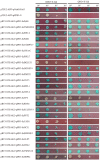Identification of Sugarcane Host Factors Interacting with the 6K2 Protein of the Sugarcane Mosaic Virus
- PMID: 31398864
- PMCID: PMC6719097
- DOI: 10.3390/ijms20163867
Identification of Sugarcane Host Factors Interacting with the 6K2 Protein of the Sugarcane Mosaic Virus
Abstract
The 6K2 protein of potyviruses plays a key role in the viral infection in plants. In the present study, the coding sequence of 6K2 was cloned from Sugarcane mosaic virus (SCMV) strain FZ1 into pBT3-STE to generate the plasmid pBT3-STE-6K2, which was used as bait to screen a cDNA library prepared from sugarcane plants infected with SCMV based on the DUALmembrane system. One hundred and fifty-seven positive colonies were screened and sequenced, and the corresponding full-length genes were cloned from sugarcane cultivar ROC22. Then, 24 genes with annotations were obtained, and the deduced proteins were classified into three groups, in which eight proteins were involved in the stress response, 12 proteins were involved in transport, and four proteins were involved in photosynthesis based on their biological functions. Of the 24 proteins, 20 proteins were verified to interact with SCMV-6K2 by yeast two-hybrid assays. The possible roles of these proteins in SCMV infection on sugarcane are analyzed and discussed. This is the first report on the interaction of SCMV-6K2 with host factors from sugarcane, and will improve knowledge on the mechanism of SCMV infection in sugarcane.
Keywords: 6K2; interaction; sugarcane mosaic virus; yeast two-hybrid.
Conflict of interest statement
The authors declare no conflict of interest.
Figures



Similar articles
-
Selective Interaction of Sugarcane eIF4E with VPgs from Sugarcane Mosaic Pathogens.Viruses. 2021 Mar 22;13(3):518. doi: 10.3390/v13030518. Viruses. 2021. PMID: 33809985 Free PMC article.
-
Comparative proteomic analysis of the plant-virus interaction in resistant and susceptible ecotypes of maize infected with sugarcane mosaic virus.J Proteomics. 2013 Aug 26;89:124-40. doi: 10.1016/j.jprot.2013.06.005. Epub 2013 Jun 14. J Proteomics. 2013. PMID: 23770298
-
Sugarcane mosaic virus employs 6K2 protein to impair ScPIP2;4 transport of H2O2 to facilitate virus infection.Plant Physiol. 2024 Jan 31;194(2):715-731. doi: 10.1093/plphys/kiad567. Plant Physiol. 2024. PMID: 37930811
-
Historical Review of Sugarcane Streak Mosaic Virus that Has Recently Emerged in Africa.Phytopathology. 2024 Apr;114(4):668-680. doi: 10.1094/PHYTO-08-23-0291-RVW. Epub 2024 Apr 22. Phytopathology. 2024. PMID: 37966994 Review.
-
Present status of the sugarcane mosaic subgroup of potyviruses.Arch Virol Suppl. 1992;5:363-73. doi: 10.1007/978-3-7091-6920-9_39. Arch Virol Suppl. 1992. PMID: 1450763 Review.
Cited by
-
Soybean Mosaic Virus 6K1 Interactors Screening and GmPR4 and GmBI1 Function Characterization.Int J Mol Sci. 2023 Mar 10;24(6):5304. doi: 10.3390/ijms24065304. Int J Mol Sci. 2023. PMID: 36982379 Free PMC article.
-
Selective Interaction of Sugarcane eIF4E with VPgs from Sugarcane Mosaic Pathogens.Viruses. 2021 Mar 22;13(3):518. doi: 10.3390/v13030518. Viruses. 2021. PMID: 33809985 Free PMC article.
-
Identification and characterization of the Remorin gene family in Saccharum and the involvement of ScREM1.5e-1/-2 in SCMV infection on sugarcane.Front Plant Sci. 2024 Feb 23;15:1365995. doi: 10.3389/fpls.2024.1365995. eCollection 2024. Front Plant Sci. 2024. PMID: 38463560 Free PMC article.
References
MeSH terms
Substances
Supplementary concepts
Grants and funding
LinkOut - more resources
Full Text Sources
Research Materials

